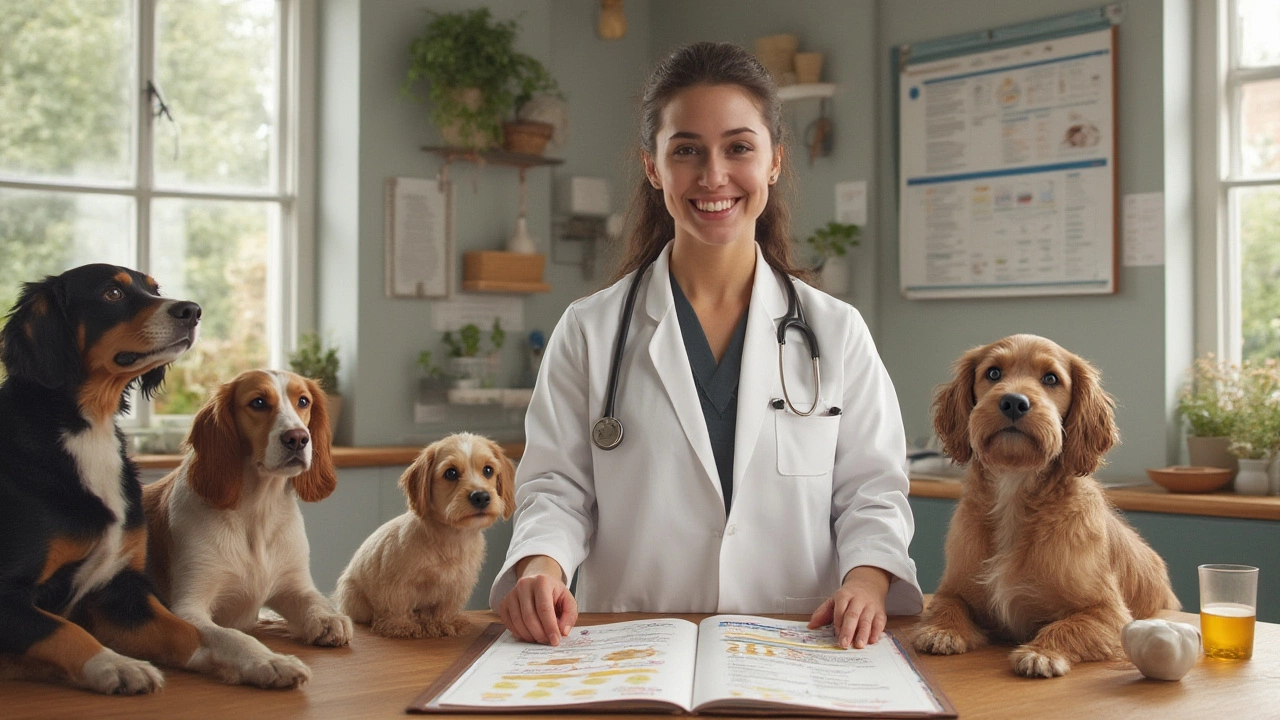Picture this: your dog is bounding through the park, tail wagging, fur shining in the sun, and you’re thinking, “Am I feeding my pup right?” You’d be surprised how much that answer hinges on one tiny—but mighty—ingredient: vitamins. With shelves full of fancy supplements, slick marketing claims, and a dizzying list of nutrients, it’s easy to get lost. But there’s one question pet owners ask more than any other: What is the single most important vitamin for a dog?
Understanding Vitamins: What Do Dogs Really Need?
Here’s something that might surprise you: dogs, just like humans, rely on vitamins for everything from keeping their hearts strong to growing a soft, shiny coat. Unlike humans, though, dogs make some vitamins on their own, but plenty must come from their food. So, which ones matter most?
Let’s break down the basics. Dogs need two main types of vitamins: water-soluble (like B and C) and fat-soluble (such as A, D, E, and K). Fat-soluble vitamins can be stored in their bodies, so getting too much over time can actually be risky. Water-soluble vitamins, on the other hand, get flushed out more easily and need to be replaced often. But there’s a catch: while every vitamin plays a role, only a handful are considered absolutely crucial for your pup’s long-term health.
According to the National Research Council’s 2006 report “Nutrient Requirements of Dogs and Cats,” certain vitamins are not just beneficial—but essential. Dogs can synthesize some vitamin C, for example, so supplementation isn’t always required. But vitamins like E, A, and B-complex? That’s another story.
Think of vitamin E as the star quarterback. It doesn’t get as much hype as vitamin C, but it’s a leader when it comes to defending the body’s cells from attack. Dog vitamins aren’t just about preventing problems—you’re supporting everything from eyesight to nerve function to immune strength.
Hidden deficiencies can creep up quietly. Maybe your older dog seems a bit stiffer, scratches more, or his fur just isn’t as glossy as last year. Signs like poor coat quality, lethargy, or skin problems could be linked to vitamin shortages. If you feed homemade diets, this risk jumps, since commercial foods are usually balanced. But don’t panic: with a bit of knowledge—and a good look at your dog’s food label—you can steer clear of those pitfalls.
Vitamin E: The Unsung Hero for Canine Health
Ready for a twist? Most veterinary nutritionists quietly agree: if there’s one vitamin your dog can’t afford to miss out on, it’s vitamin E. Why? Unlike some other vitamins, dogs can’t make it themselves. And the jobs it handles are massive.
Vitamin E fights free radicals—those pesky molecules that mess with cells and speed up aging or disease. It shores up your dog’s immune system. It even supports heart health, muscles, and skin. Take this real-world fact: one out of three dogs fed high-fat homemade diets but left short on vitamin E started developing muscle weakness within months, according to a study published by the Journal of Nutrition.
But it’s not just rare; low vitamin E levels show up quietly. Look out for symptoms like weakness, reproductive problems, poor coat condition, and vision issues. Growing puppies forced to live without vitamin E might develop something called ‘yellow fat disease’ (scientifically, pansteatitis) because their bodies can’t manage fats correctly without it.
You probably didn’t know this, but heat and storage can sap vitamin E from food. That’s why it’s often added back into high-quality commercial foods. If you feed raw or cook at home, you might need a supplement since it’s easy to miss. What about overdosing? Take it easy—mega doses can cause tummy troubles and even hurt vitamin K absorption, which dogs need for blood clotting.
Look at this handy table showing how much vitamin E your dog actually needs daily based on weight:
| Dog Weight (lbs) | Recommended Vitamin E (IU/day) |
|---|---|
| 10 | 6 IU |
| 30 | 18 IU |
| 50 | 30 IU |
| 80 | 48 IU |
What’s in your dog’s food? Flip that label over. Most commercial dry and canned foods list vitamin E (often as “dl-alpha tocopherol acetate”). If you’re home-cooking for your pooch, always double-check or ask your vet if your homemade menu covers it. Some top sources: wheat germ oil, sunflower oil, and nuts (skip the macadamia, they’re toxic!).
Dr. Lisa Freeman, a veterinary nutritionist at Tufts University, put it simply:
“Vitamin E is critical for dogs, especially when fed higher-fat or fish-based diets. Don’t skimp on it if you want to protect your pet’s long-term health.”
Daily needs aren’t the same for every dog, either. Larger breeds, older dogs, or pups with special needs (like skin allergies or chronic conditions—they burn through antioxidants faster) sometimes need a little extra. Don’t guess though! Too much can mess with absorption of other vitamins.

Do All Dogs Need the Same Vitamin Intake?
Here’s where things get a bit trickier. Everyone likes a one-size-fits-all answer—but your dog’s best friend might need something totally different. Age, size, activity level, and even breed can affect how much vitamin E (and other vitamins) a dog needs.
Puppies, for starters, are growing fast and burn through nutrients quickly. Senior dogs, meanwhile, have slower metabolisms but might struggle with absorption. Active dogs and working breeds actually use up vitamin E faster than their stay-at-home counterparts thanks to muscle use and stress. And dogs with medical conditions—from allergies to heart issues—may need adjustments, too.
Here’s the twist: small breeds don’t necessarily need less per pound. In fact, tiny dogs often have higher metabolic rates, meaning they might go through nutrients even faster. And foods with extra fat, like those marketed for ‘shinier coats,’ actually demand more vitamin E to process all that oil safely. If you’ve got a picky eater, or a dog with digestion troubles, talk to your vet—a deficiency can show up when you least expect it.
People often ask if certain breeds are more at risk for vitamin problems. Labradors, with their oily coats, can actually need more E, especially if they eat fish-based foods (which oxidize faster). Huskies and collies, with their double-layer coats, may need an extra boost to keep those thick manes healthy. Flat-faced dogs with chronic skin problems—think bulldogs—also benefit from the anti-inflammatory powers of vitamin E.
It’s tempting to grab a bottle of doggy vitamins, but remember: more isn’t always better. Vitamin megadoses can do more harm than good. The golden rule? Stick to balanced foods, supplement with care, and always consult a vet when you make changes.
Other Vital Vitamins Dogs Can't Live Without
While vitamin E steals the spotlight, it’s just one part of a big nutritional orchestra. Several other vitamins are crucial for canine health—and skipping them can lead to serious, sometimes life-threatening, issues. Let’s break them down:
- Vitamin A: Vital for vision, skin health, and immune support. Deficiency can show up as dull fur, scaling skin, and blindness. Overdoing it (especially with liver treats!) can actually lead to toxicity.
- B Vitamins: Think of these as the energy boosters. They’re behind everything from brain function (B1, B6, B12) to skin and digestion (niacin, pantothenic acid). Low B vitamins often cause poor appetite, weight loss, and weak nerves.
- Vitamin D: Helps the body absorb calcium, so it’s essential for bones and teeth. Since dogs can’t make enough vitamin D from sunlight alone (unlike people), it’s got to come from their food. Too much or too little messes with bones or can be toxic.
- Vitamin K: Key for blood clotting. Deficiency isn’t common unless dogs have eaten rat poison or certain medications, but it’s still vital for life. Good news: gut bacteria make plenty, unless antibiotics wipe them out.
Missing out on these means trouble. That’s why all AAFCO-approved commercial dog foods (that’s the gold standard for pet food in the U.S.) are fortified with these vitamins. Homemade diets? Far riskier. In fact, a 2021 study published in Frontiers in Veterinary Science found that 86% of home-prepared dog recipes were missing one or more essential nutrients. That cute recipe from Instagram probably won’t cut it for serious, daily nutrition.
If you’re committed to home cooking, see a board-certified veterinary nutritionist (find one at acvn.org). They’ll help craft a balanced plan with the right supplements. And with store-bought foods? Rotate high-quality options, watch for recalls, and double-check those labels.
| Vitamin | Daily Requirement* | Main Dietary Sources |
|---|---|---|
| Vitamin E | 6-48 IU | Oils, leafy greens, seeds |
| Vitamin A | 380 IU/kg | Liver, eggs, carrots |
| B-Complex | Varies | Meat, grains, legumes |
| Vitamin D | 0.075 IU/lb | Fish liver oil, egg yolk |
| Vitamin K | Varies | Leafy greens, synthesized in gut |
*Based on AAFCO minimums for adult dogs.

How to Spot Deficiencies—And What to Do
You know how dogs can’t exactly tell us what’s wrong, so the clues show up in their bodies. The most common deficiency signs? Dull coat, itching, fatigue, poor wound healing, and weird eating habits like chewing on dirt or licking strange surfaces. In more severe cases, you’ll see neurological symptoms (shakes, confusion), muscle weakness, and even seizures.
If you spot any of these, don’t just add supplements and hope for the best. Call your vet. Blood work can uncover hidden shortages or help trace problems before they get out of hand. It’s smart to keep a food diary, especially if you switch brands or cook at home—you’ll have a record ready for your vet if things go wrong.
Shopping for a supplement? Only buy from brands with NASC (National Animal Supplement Council) or VOHC (Veterinary Oral Health Council) seals. These groups run quality checks so you’re less likely to get a bottle full of fillers or dangerous levels. Watch for expiration dates, store out of the sun, and skip “human” supplements unless your vet approves them—doses and forms can be wildly different.
Cooking for your dog? Rotate fats like olive oil, canola, or sunflower to add a mix of vitamin E, but avoid “fad” diets (think: raw-only, vegan, or extreme low-fat) unless you’re working with an expert. Those trends can trigger massive vitamin gaps. Even recipes from popular online forums have been busted by researchers for leaving out critical nutrients.
Experts remind us that even the world’s healthiest diet won’t work if your dog won’t eat it. Palatability matters. If you’re switching diets or brands, do it slowly. That way you won’t upset your pup’s stomach or cause him to turn up his nose.
So, keep an eye on food labels, talk with your vet regularly, and remember: when it comes to vitamins, balance is everything. Your dog will thank you with energy, glossy fur, and that famous wiggly butt.

